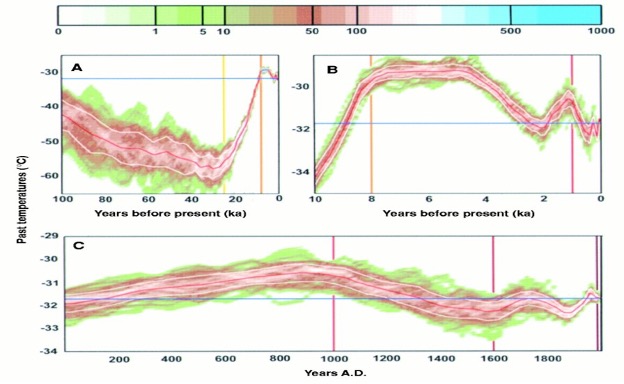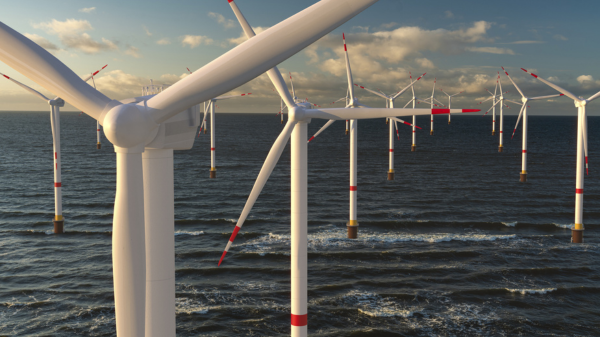YOU SHOULD SUBSCRIBE TO CLIMATE CHANGE WEEKLY.
IN THIS ISSUE:
- New Claims of Record-Setting Temperatures Are Nothing but Hot Air
- Wind Power May Be a Net Carbon-Dioxide Emitter
- U.N. Net-Zero Insurance Alliance Loses Members, Weakens Standards
- Climate Comedy
- Video of the Week: Debunking Media Myths about Heat Waves, Droughts, and Floods on Laura Ingraham’s Show
- BONUS Video of the Week: Biden Banning ALL Your Home Appliances
Miss Anything at Heartland’s Climate Conference? No Problem.
New Claims of Record-Setting Temperatures Are Nothing but Hot Air

Headlines last week in mainstream media such as the BBC, CNN, Forbes, and The Washington Post blared the consistent message that July 4, 2023 was the hottest day in history, or at least in the past 125,000 years. The headlines and stories show just how gullible the media is, or alternatively, that they are so wedded to the climate crisis narrative they would publish a story they know is impossible to verify and is probably untrue.
The Washington Post’s (WP) story was typical of the foolish claims in the mainstream media, “This July 4 was hot. Earth’s hottest day on record, in fact.” What the WP presented as a “fact” was nothing more than computer model speculation based on a wide variety of disparate types of data from satellite measurements to surface data, etc., blended and reanalyzed to produce an alarming but unsubstantiated result. Although the WP claimed the data was from the U.S. National Centers for Environmental Prediction, it wasn’t. The WP’s claims, as with the those made in the headlines and alarming stories in other so-called news outlets, came from a single source: the “Climate Reanalyzer” at the Climate Change Institute at the University of Maine (UM).
UM’s Climate Reanalyzer is not an official U.S. government source of data and does not produce original data. Instead, it manipulates and reframes data from other sources. Had the WP or other mainstream media outlets bothered to check with the National Oceanic and Atmospheric Administration about the claims of record-setting heat, they would have found the agency said surface temperature data does not confirm global high temperature records were broken in early July.
Still, Paulo Ceppi, a climate scientist at London’s Grantham Institute, told the WP with confidence, “It hasn’t been this warm since at least 125,000 years ago, which was the previous interglacial.” The WP apparently didn’t even think to question that claim.
In addition to the fact that the idea of a “global average temperature” is a made-up statistic having no real weather or climate meaning, there were no weather satellites even 50 years ago, nor ground-based measuring stations in more than a smattering of locations more than 150 years ago, much less hundreds of thousands of years ago.
“One obvious problem with the updated narrative is that there are no satellite data from 125,000 years ago,” wrote Steve Milloy, operator of JunkScience.com, in a Wall Street Journal article. “Calculated estimates of current temperatures can’t be fairly compared with guesses of global temperature from thousands of years ago.”
Climate analyst Paul Homewood made a similar point, writing,
The idea that we know the global temperature today is absurd in itself. But the idea that we actually know what it was on a given day 100 years ago, or 1000 years ago, never mind thousands of years ago is sheer fraud.
And the claim that it is hotter now than 5000 years ago is a total lie—there is abundant evidence that it was much warmer then.
Worse still for the “hottest day ever narrative” is that the measured average temperature on July 4, actually recorded around the world, is much less than claimed. Milloy notes,
A more likely alternative to the 62.6-degree estimate is something around 57.5 degrees. The latter is an average of actual surface temperature measurements taken around the world and processed on a minute-by-minute basis by a website called temperature.global. The numbers have been steady this year, with no spike in July.
As Heartland Institute President James Taylor writes in a Climate Realism post on the topic, numerous sources such as the U.N. Intergovernmental Panel on Climate Change and peer-reviewed research published in the journal Science show historic temperatures have been warmer for long stretches of time since we came out of the last ice age approximately 12,000 years ago, when human civilizations began to form, than they are at present. Taylor writes,
[H]istorical temperatures derived from ice core samples, as reported in the peer-reviewed journal Science … shows the warming of the past 150 [years] leaves current temperatures well below temperatures that have predominated during most of the time period that human civilization has existed. (see the figure below)

The chart below from the IPCC also contradicts the claim that July 4, 2023 or any of the days that followed established new global temperature records:

I’m not familiar enough with the UM’s Climate Reanalyzer to judge whether is a useful tool for some purpose or set of purposes beyond generating alarming but false headlines about climate change. In any case, the “data” it generates, if it can be called that, should in no way, shape, or form be taken as authoritative or used in place of actual temperature measurements when presenting local, regional, or global average temperatures.
The mainstream media should be ashamed of itself for hyping yet another big climate lie.
Sources: Climate Realism; The Wall Street Journal (behind paywall); Watts Up With That
Get your Copy at Amazon TODAY!

Wind Power May Be a Net Carbon-Dioxide Emitter

In a series of articles, David Wojick, Ph.D., former consultant to the U.S. Department of Energy and erstwhile staffer at the U.S. Office of Naval Research, explains that expanding the use of wind power results in higher net carbon dioxide emissions rather than reductions as promised, because of the way the power system functions.
Wojick’s analysis, in this instance, focuses primarily on offshore wind, finding that from production to construction through operation it is a net carbon-dioxide emitter.
On the construction side, Wojick calculates,
Each [monopile] weighs something like 2,500 tons. It is first driven into the seafloor, then hollowed out and backfilled with concrete.
Steel and cement-making both create a lot of CO2 emissions, and there are so-called emission factors for both. Steelmaking creates about 2 tons of CO2 per ton of steel, so just producing the raw steel in one monopile puts out 5,000 tons of CO2. This does not include making the monopile, which involves a lot of shaping, cutting, welding, etc.
There is something like 15,000 tons of concrete in a finished monopile, and the chemical emission factor is about 1,250 pounds of CO2, giving around 9,000 tons of CO2 per pile. This does not include the energy required for cooking the limestone to make cement, which requires a great deal of heat.
So, simply producing the basic materials causes about 14,000 tons of CO2 per monopile. Assuming for simplicity that the average turbine is 11 MW we need 1,000 monopiles [for a single planned wind development in New Jersey], which works out to a whopping 14,000,000 tons of CO2 just to make the steel and concrete.
This calculation does not include the emissions from the mining and refining of the ore used to make the steel, or the mining and refining of the copper used in the cables, or the critical minerals and rare earths used in the electronics through which the power generated is managed and transported, Wojick notes. Nor does it include the emissions generated during the creation of the turbine blades and gear boxes (nacelles), or the emissions from the rare earth mining for the magnets in the nacelles, or emissions generated during the transportation of the parts and their assembly.
And that’s just the emissions from the construction side of offshore wind. Long-term, the emissions from the operation of wind turbines, their intermittency, and the sources of power used to back them up may result in more emissions than if nuclear (which is zero-emission but is being replaced by wind) or natural gas use had continued, Wojick points out.
Wind speeds are not constant, and sustained optimum wind speeds to keep turbines operating at peak generation efficiency are unusual. As a result, electricity generated by wind turbines is in constant need of supplement and regulation when winds are blowing but powered by variable gusts (as is the norm), and of replacement when winds are not blowing at all or going too slowly or too fast, with turbine operations having to be shut down in order to avoid their destruction in the latter case.
The most likely replacement or supplementary power source for offshore wind for the foreseeable future is simple-cycle natural gas plants, which are relatively inefficient, generating less energy and producing more emissions than combined-cycle plants. The latter are more efficient than simple-cycle plants and produce lower emissions during peak operations, but they work well only when they can be run at peak power. This is not an option when used as a supplement or temporary replacement for intermittent and variable electricity generated by wind. Simple-cycle plants are ideal for such situations, which is why they serve as peaker plants—facilities used to provide additional power to the grid during peak demand. They can be turned on and off and ramp up and down quickly.
Using combined-cycle plants to supplement or replace wind burns more gas per unit of energy produced, with a corresponding increase in emissions.
From production to construction through operation, it is likely offshore wind use will result in an increase in carbon dioxide emissions, not a decrease. And the latter is the only reason they are being foisted on the public in the first place.
Sources: Stop These Things; CFACT
Heartland’s Must-read Climate Sites
U.N. Net-Zero Insurance Alliance Loses Members, Weakens Standards

The Net-Zero Insurance Alliance (NZIA) was convened by the United Nations under the auspices of the U.N. Environment Programme (UNEP) to develop commitments, plans, and timetables for insurers to reduce carbon-dioxide emissions throughout their supply chains and operations to net zero by 2050, accounting for the governments, companies, and people they insure. The NZIA also required insurers to report their progress on a set timetable. At one point the NZIA counted 30 of the largest global insurance/reinsurance companies as members.
In recent months the NZIA has been shedding members rapidly, currently counting only 12 firms as participants. Citing pressure from 23 states’ attorneys general who have threatened to sue the firms for violating U.S. antitrust laws and artificially increasing insurance costs in the process, firms are leaving the coalition and rescinding their net-zero commitments. The most recent international firms to withdraw from the NZIA are Allianz and Tokio Marine.
To keep NZIA a going concern, retain its remaining members, and open the door for members that have withdrawn to rejoin, the NZIA has decided to revise its rules significantly, ending the coordinated net-zero plans—much to the consternation of environmental groups.
“Going forward, NZIA member companies have no obligation to set or publish targets: rather, individual member companies will be responsible and publicly accountable for any targets they set, the methodologies used to set them, the timeline on which they decide to publish any targets, and the progress they are making,” the UNEP said in a statement.
Under the NZIA’s previous Target-Setting Protocol, “insurance members had until end-July to publish emissions targets for 2030 using recommended types of targets and were then required to update on their progress annually,” Reuters reports.
Although the new guidelines encourage members and nonmembers alike to use the NZIA’s target-setting protocol and its methodologies, it is now “a voluntary best practice guide” for constructing independently developed net-zero plans and comparing various emission-reduction results.
“Each company who chooses to be a member of the NZIA unilaterally and independently decides on the steps on its path towards net zero [under the new set of rules],” the UNEP stated in announcing the changes, stressing, “NZIA membership does not involve any coordinated competitive conduct or exchanges of competitively sensitive information.”
Source: Reuters
Heartland’s Must-read Climate Sites
Heartland Institute President James Taylor was on the Ingraham Angle on Fox News this week to say the idea that humans are experiencing the hottest weather ever is just ludicrous.He also cites data from government weather and climate agencies showing that talk of record drought and floods is also nonsense. In waterways not manipulated by man, Taylor said, there is no increase in flooding from historical data. And areas in the US experiencing “drier-than-normal conditions” have actually decreased.
Introduced by Laura as one of the top environment and energy experts in the country, James Taylor debunked the narrative that humans are causing a “climate crisis” — as he does on a lot of media.
Biden Banning ALL Your Home Appliances
We recently learned from Heartland’s Justin Haskins that the U.N. is planning to seize global “emergency” powers with Biden’s support. In the article, Haskins makes it clear that a so-called “climate emergency” or “climate crisis” will be one of the possible triggers for this, and with the upcoming El Niño likely to spike global temperatures, irrational panic will likely enable a power grab by the UN.
Just this week, when there was supposedly the “hottest day ever” on the planet (it wasn’t, even NOAA couldn’t confirm it), U.N. Secretary-General Antonio Guterres said the latest numbers help prove “that climate change is out of control.”
Watch this episode of Heartland’s Climate Change Roundtable for a review of this madness. Anthony Watts, H. Sterling Burnett, and Linnea Lueken also take a look at some of the silliest climate news of the week, including the so-called “hottest day ever” that coulda, sorta, mighta happened this week!
Watch every episode of The Heartland Institute’s Climate Change Roundtable show LIVE every Friday at 1 p.m. CT.
Climate Comedy
 via Cartoons by Josh
via Cartoons by Josh





























